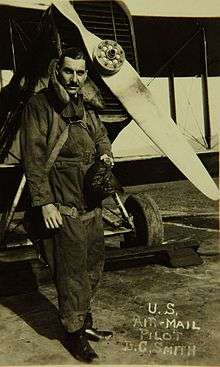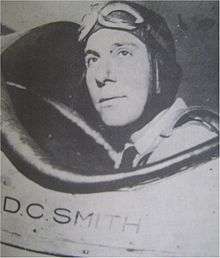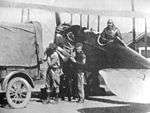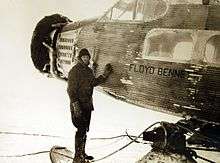Dean Smith (pilot)
| Dean Smith DFC | |
|---|---|
 Smith c. 1924 | |
| Born |
Dean Cullen Smith September 27, 1899 Cove, Oregon |
| Died |
March 4, 1987 (aged 87) Maryland |
| Nationality | American |
| Other names | The Dean |
| Occupation | Pilot |
| Employer | |
| Known for | Byrd expedition |
| Height | 6 ft 3 in (1.91 m) |
Dean Cullom Smith (September 27, 1899 – March 4, 1987) was a pioneer American mail pilot, test pilot, flying instructor, Antarctic pilot, and airline pilot. At 17 years of age, he became the youngest flight instructor in U.S. Army history. He was a lead pilot for the U.S. Postal Service's airmail service, and was the first pilot to initiate night air mail flights. He was an executive for many airlines and aircraft companies.
Smith was a pilot for the Byrd Antarctic Expedition of 1928–1930 involved in aerial overflights to discover new land that could be claimed for the benefit of the United States. The land was later viewed by Byrd and named after his wife. Smith was awarded the Distinguished Flying Cross and the Congressional Gold Medal. An Antarctic peak bears his name. He was inducted into the New Jersey Aviation Hall of Fame in 1986.
Early life and Education
Smith was born in Cove, Oregon, on September 27, 1899[1][2] at his grandparents home.[3] His parents were Joshua Cullow Smith and Rhoda Harris Smith.[4] When he was three years old he traveled with his family to Central America where his father's business was headquartered.[3] He would often run away from home to go to his grandmother's to hear her talk about the pioneer days of covered-wagons.[3] As a child, Smith attended public schools in Oregon.[4] After high school he attended two years at Principia College in St.Louis, Missouri, but did not graduate.[3]
Mid life and career

Smith enlisted in the aviation Section of the United States Signal Corps in July 1917, several months before his eighteenth birthday. Soon after he enlisted, he was promoted to master signal electrician, the highest non-commissioned rank of the US Army Signal Corps. [5][3] During this time, he was the youngest enlist to serve in the capacity. In this position he was able to promote himself to be a cadet in Ground [upper-alpha 1]
At 17, Smith became the youngest ever flight instructor in U.S. Army history after receiving just under 57 hours of flying instruction.[5] Though he volunteered to serve overseas to the front lines with the American Expeditionary Forces, he was posted as a flying instructor at Fort Scott. He was promoted to second lieutenant and stayed in the United States for the duration of his service duties.
From August 1918 to January 1919, Smith was assigned to Gosport Instructor's School in San Antonio, Texas, as an Army flight instructor.[4] Later he was then transferred to Rockwell Field in San Diego to teach at the Pursuit School of Instruction, where he remained until he was discharged in March 1919.[6] Subsequently, Smith flew as a barnstormer for about a year at carnivals.[5] He also gave five-minute rides, for five dollars each, at county fairs in various states during this time.[3] Eventually he destroyed his plane and discontinued these ventures.[3]
Smith was instrumental in the inauguration of the air mail service by the United States Postal Service (USPS) in the summer of 1919.[7] He had logged 900 hours of flying time in the Army before he joined the U.S. Mail Service at age nineteen.[2] His first assignment was to fly mail from Omaha, Nebraska, to California, essentially following the same route as the Oregon Trail. His mother had taken this trail by covered wagon from Council Bluffs, Iowa, to Cove, Oregon, in 1871. His mother and grandparents had taken two years to complete their trip, whereas Smith flew his route to California within a week with several stops along the way.[3]

He became an official air mail pilot on May 21, 1920.[8] He helped to develop a transcontinental route that included the technology of flying using electronic instruments.[9][3][10] The next segment he added later was from Cleveland to Chicago and that leg was later extended to Omaha.[3]
Flying planes carrying air mail, day or night, was hazardous and accidents happened often, more so even than in barnstorming.[9] Smith worked as an air mail pilot until August 31, 1927.[11] In his association with USPS for more than 7 years, he logged 3764.57 hours and flew 365,719 miles (588,568 km).[1] Smith was permanently stationed at Bellefonte, Pennsylvania, as an air mail pilot starting in May 1920.[1][12] He often flew from there in and out of Cleveland and used the De Havilland Airco DH-4B aircraft for the delivery of airmail.[1][13][14]
"On Trip 4 westbound. Flying low. Engine quit. Only place to land on cow. Killed cow. Wrecked plane. Scared me. Smith." – Telegram
Smith reported in his autobiography, during one run from Omaha to Cheyenne, that he had had to ditch into a pasture, landing on a cow.[3] He sent a laconic telegram to his division supervisor at headquarters in College Park, Maryland,[15] reporting the mishap.[3] Crashes were part of the job. Engines were unreliable, and pilots were using road maps. Unpredictable, bad weather was a constant risk. In the first five years of US Post Office air mail service the average forced landing was every 800 miles and a pilot was killed about every 80,000 miles.[9] Thirty-five pilots died during the Postal Service's operation of air mail flights; most deaths were between 1920 and 1925.[16]
Smith was involved in another incident that scared him to death. One day when he was flying his normal air mail route from Hadley Field to Cleveland, he caught something out of the corner of his eye that looked like a skyscraper. He pulled back on the control stick to quickly gain altitude and just missed hitting the U.S. Navy airship USS Los Angeles that was in his direct path. It was a close call of just over a hundred feet.[3]
Byrd expedition

In 1928, Smith was selected as a pilot for the Byrd Antarctic Expedition of 1928–1930 from a list of over 25,000 pilots.[3][17][18] Byrd selected Smith not only for his all-weather experience, but because of the respect he had for Smith's mother after meeting her.[19] Smith flew a three-engined Ford Trimotor plane named the Floyd Bennett (named in Bennett's honor) and headed for the South Pole on August 25, 1928.[20] He logged 70 hours of Antarctic flying during the time he was at the South Pole with Admiral Richard Byrd.[21]
Smith flew Antarctic missions with Bernt Balchen, a Norwegian, who piloted the first plane to traverse the South Pole. He was a pilot involved in aerial overflights to discover new land in Antarctica that had not been claimed by other countries.[22] One was a Matterhorn-like mountain,[23] and surrounding region which was named Marie Byrd Land in honor of Byrd's wife.[24][25] The mountain range was seen first by Smith before Byrd saw it.[26] Byrd claimed his "pet mountain" for the United States and a narrative of Byrd's story, and how the land got his wife's name, was published in The New York Times of February 21, 1929.[27][28]
Smith returned from the expedition to his home town in Oregon for a festive welcome on July 21, 1930. Among the many questions the crowd had for him, the one that stood out was a question about the most impressive thing he experienced while at the South Pole. His answer was of the notable silence in the Antarctic. He accounted for this by remarking that no woman had ever been there.[29] Smith went back to the air mail delivery after being at the South Pole for two years with Byrd, even setting a record on the notorious "hell stretch" over mountains in Pennsylvania.[30]
Later life and death
Throughout his career in aviation, Smith worked for various companies such as Learning Curtiss Company, Fairchild Aviation, Hughes Tool Company, Douglas Aircraft Company, American Airlines, and United Airlines at one time or another, in various capacities.[31] He died in Maryland on March 4, 1987.[32]
Though he stopped flying commercially in 1943, Smith continued his work with the aircraft and aviation industryy. In 1973, he returned to New Zealand after more than 40 years as a guest for Air New Zealand on its first flight of McDonnell Douglas DC-10, this time as a passenger. He also was on board for a landing on the Tasman Glacier, passing through Milford Sound and Mount Cook, New Zealand.[5]
Personal traits
Smith was nicknamed "The Dean" because of his given name. As an adult he was 6 feet 3 inches tall, weighed 180 pounds, and had black hair.[19] He was known as a man of few words.[33] Some claimed his extreme shyness was unexpected, given his large size.[3] Smith married Mrs. Elizabeth Schuyler on January 3, 1931.[34]
Societies
Smith was a member of the Aero Club of America.[4] He was also a member of several pioneer aviator groups including the Air Mail Pioneers Association and the Quiet Birdmen. He was the last president of the National Air Pilots Association, as it was subsumed in 1932 into the Airline Pilots Association.[9][35] As a pioneer flier, he was named to the Curtiss OX5 and Aviation Halls of Fame.[9]
Awards
Smith was decorated in 1930 with the Distinguished Flying Cross for assisting Byrd.[36][37][38] He received the Harmon Trophy in 1934 for being America's most outstanding aviator.[31] Smith was also a recipient of The Detroit News Aerial Trophy.[5][9] He was a featured aviator in Chasing the Sun, a public television documentary on commercial aviation, produced by KCET Hollywood.[39]
Legacy
Smith Peak 72°10′S 99°18′W / 72.167°S 99.300°W,[40] a prominent peak in the Walker Mountains on Thurston Island off the Eights Coast of Ellsworth Land was named after Smith as — "a permanent reminder of the role Dean Smith played in Byrd's first expedition." In 1946 it was delineated from aerial photographs taken by the U.S. Navy's Operation Highjump, and so-named by the U.S. Advisory Committee On Antarctic Place Names (ACAN).[5]
Published works
- Smith, Dean C. (1961). By The Seat of My Pants: A Pilot's Progress From 1917 to 1930 (1st ed.). Little, Brown. ASIN B0007DQ824.
See also
Notes
- ↑ "After 56 hours and 45 minutes of flying instruction at Kelly Field, Texas, Smith was commissioned as a second lieutenant but did not go overseas in World War I. He showed so much promise as a flight instructor — at 17 the youngest in U.S. Army history — that he was retained for the duration training for flying service."[3]
References
Citations
- 1 2 3 4 5 Pope, Nancy A. (2016). "PILOT STORIES: Smith, Dean C.". National Postal Museum. Smithsonian Institution. Retrieved July 19, 2016.
- 1 2 Collins 1983, p. 84.
- 1 2 3 4 5 6 7 8 9 10 11 12 13 14 15 16 Interesting People /A Wrestler of Winds, New York City: The American Magazine, December 1929, p. 68
- 1 2 3 4 Gardner 1922, p. 93.
- 1 2 3 4 5 6 Caffin 1987, p. 228.
- ↑ Smith 1961, p. 88.
- ↑ Smith 1961, pp. 91–144.
- ↑ Oliver 1980, p. 33.
- 1 2 3 4 5 6 7 Folkart 1987.
- ↑ This was needed for the air mail service that the USPS intended to provide. Smith was the first pilot to initiate night air mail service. His first route was from Hadley Field in New Jersey to Bellefonte in Pennsylvania and then from there to Cleveland, Ohio, a distance of 394 miles along a four hour lighted route.Wright, Nancy Allison, President Air Mail Pioneers (1999). "Story of Hadley Field and Dean Smith as the first night air mail pilot". Air Mail Pioneers. Retrieved July 1, 2016.
- ↑ Wright, Nancy Allison (1999). "Air Mail Pioneers". Dedicated to the former employees of the U.S. Air Mail Service. President Air Mail Pioneers. Retrieved July 19, 2016.
- ↑ Oliver 1980, p. 34.
- ↑ Oliver 1980, p. 35.
- ↑ Pope, Nancy A. "deHavilland DH-4". National Postal Museum, Smithsonian Institution. Retrieved July 21, 2015.
- ↑ Oliver 1980, p. 31.
- ↑ "They died flying the mail". National Postal Museum, Smithsonian Institution. Retrieved July 21, 2016.
- ↑ "Personnel Selected by Byrd for his Antarctic Trip; More Than 15,000 Asked For Place". The Brooklyn Daily Eagle. Brooklyn, New York. August 8, 1928 – via Newspapers.com
 .
. - ↑ "Cousin of Dean Smith Watches News Eagerly". La Grande Observer. La Grande, Oregon. January 6, 1930 – via Newspapers.com
 .
. - 1 2 Rodgers 1990, p. 90.
- ↑ "Byrd Expedition will be Started Tomorrow". The Bee. Danville, Virginia. August 24, 1928 – via Newspapers.com
 .
. - ↑ "Dean Smith HERE". Oakland Tribune. Oakland, California. July 21, 1930 – via Newspapers.com
 .
. - ↑ Rodgers 1990, pp. 96, 97.
- ↑ Rodgers 1990, p. 194.
- ↑ Brisbane, Arthur (February 23, 1929). "T o d a y". Reading Times. Reading Pennsylvania – via Newspapers.com
 .
. - ↑ "New Land for the U. S. A.". Pittston Gazette. Pittston, Pennsylvania. March 11, 1929 – via Newspapers.com
 .
. - ↑ Rodgers 1990, pp. 99, 100, 195.
- ↑ Rodgers 1990, p. 98.
- ↑ Owen, Russell (2016). "BYRD SEES VAST NEW ANTARCTIC AREA FROM HIS PLANE, CLAIMS IT FOR NATION; NAMES IT FOR WIFE, MARIE BYRD LAND; PEAKS RUN TO 10,000 FEET". The New York Times / United States Edition. Little America, Antarctica: The New York Times Company. Retrieved July 27, 2016.
- ↑ "Dean Smith is welcomed in Portland / Member of Byrd's Antarctic Expedition Given Great Greeting". La Grande Observer. La Grande, Oregon. July 22, 1930 – via Newspapers.com
 .
. - ↑ "Dean Smith, Hero of Byrd Flight, Hangs Up New Mail Record". The News-Herald. Franklin, Pennsylvania. September 23, 1930 – via Newspapers.com
 .
. - 1 2 Rodgers 2012, p. 90.
- ↑ Lee, Paul (2005). "DEAN CULLOM SMITH". An organization of pioneers who flew solo before December 17, 1916. The Early Birds of Aviation. Retrieved July 19, 2016.
- ↑ "Magazine has Life Sketch of Dean Smith". La Grande Evening Observer. La Grande, Oregon. November 23, 1929. p. 1 – via Newspapers.com
 .
. - ↑ "Dean Smith Weds New York Woman". La Grande Observer. La Grande, Oregon. January 6, 1931 – via Newspapers.com
 .
. - ↑ "Cash Lack Disbands Air Pilots' Group". The Brooklyn Daily Eagle. Brooklyn, New York. April 13, 1932 – via Newspapers.com
 .
. - ↑ "Dean Smith is Decorated Today by Sec. Hurley". La Grande Observer. La Grande, Oregon. July 9, 1930 – via Newspapers.com
 .
. - ↑ "Medals for Byrd-Men". Wilkes-Barr Evening News. Wilkes-Barr, Pennsylvania. July 11, 1930 – via Newspapers.com
 .
. - ↑ "Decorations United States Army 1862 – 1926 (pg. 73)" (PDF). US Archives. US War Department. 1936.
For extraordinary achievement while participating in aerial flights as one of the pilots of the 1928–30 Byrd Antarctic Expedition. Lieutenant Smith made numerous flights over the Antarctic regions in the face of the gravest danger and performed his duties in such a manner as to bring great credit to himself, the expedition, and the United States Army.
- ↑ Linan, Steven (July 2, 2001). "Chasing the Sun Takes Flight on PBS". Los Angeles Times. Retrieved 14 August 2016.
- ↑ "Smith Peak: Antarctica". ITA. Retrieved 14 August 2016.
Bibliography
- Caffin, James (Autumn 1987). "Obituaries: Veterans of four nations pass from polar scene: Dean Smith flew with Byrd in 1929 (Bulletin 11)" (PDF). Antarctic. Christchurch, N.Z: New Zealand Antarctic Society. 11 (5): 226–227. ISSN 0003-5327. Retrieved July 31, 2016.
He showed so much promise as a flight instructor – at 17 the youngest in U.S. Army history – that he was retained for the duration.
- Collins, Paul F. (1983). Tales of an old air-faring man: a half century of incidents, accidents, and providence : the reminiscences of Paul F. Collins. UWSP Foundation Press.
- Folkart, Burt A. (March 17, 1987). "OBITUARIES: Dean Smith; U.S. Airmail Pioneer Flier". Los Angeles Times. Retrieved July 20, 2016.
- Gardner, Lester Durand (1922). Who's who in American Aeronautics. Aviation Publishing Corporation.
- Oliver, Carl R. (October 1980). Plane talk: aviators' and astronauts' own stories. Houghton Mifflin. ISBN 978-0-395-29743-8.
- Rodgers, Eugene (1990). Beyond the Barrier: The Story of Byrd's First Expedition to Antarctica. Naval Inst Press. ISBN 978-0-87021-022-8.
- Rodgers, Eugene (11 October 2012). Beyond the Barrier. Naval Institute Press. ISBN 978-1-61251-188-7.
- Smith, Dean C. (1961). By The Seat of My Pants: A Pilot's Progress From 1917 to 1930 (1st ed.). Little, Brown. ASIN B0007DQ824.
Further reading
- Heppenheimer, T. A. (March 13, 1995). Turbulent Skies: The History of Commercial Aviation (Paperback). Wiley. ISBN 978-0-471-19694-5.
- Lajotte, Charles A. (October 1936). "When the Air mail was a pup". Western Flying.
External links
| Wikimedia Commons has media related to Dean Cullom Smith. |
- Historic pictures of Dean C. Smith
- Wright, Nancy Allison, President Air Mail Pioneers (1999). "Story of Hadley Field and Dean Smith as the first night air mail pilot". Air Mail Pioneers. Retrieved July 1, 2016.
- Smith's honeymoon picture with new bride at Miami air races in 1931
- Dean Cullom Smith 1899–1987 at earlyaviators.com